Azelaic acid and niacinamide are two of the most popular ingredients in skincare. Azelaic acid can help with acne, hyperpigmentation and reduce inflammation.
Niacinamide has anti-aging benefits, is brightening, and has been shown to promote collagen production, which leads to firmer skin. They also both have antioxidant properties.
So, can you use azelaic acid and niacinamide together in your skincare routine?
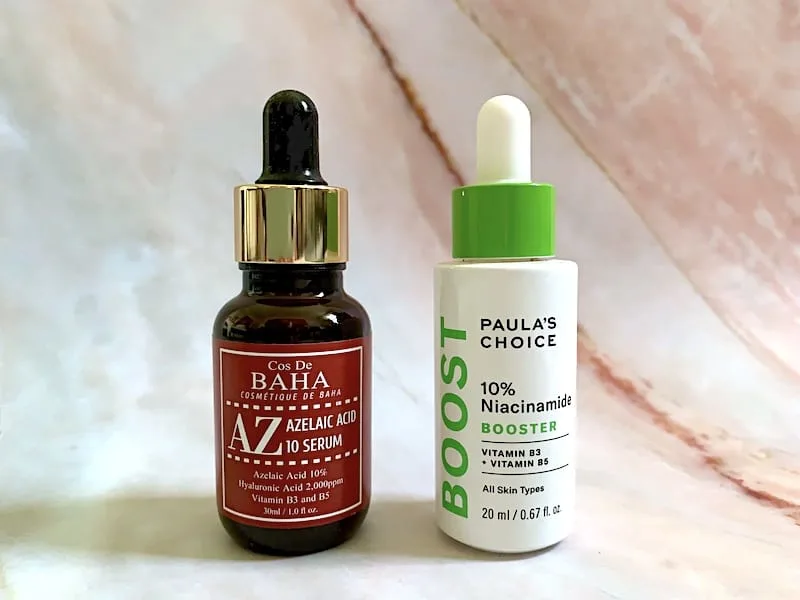
The good news is that niacinamide and azelaic acid are compatible and can be used in the same skincare routine.
Let’s take a look at why you’d want to use both of these actives and how they can help your skin.
This post contains affiliate links, and any purchases made through these links will result in a commission for me at no extra cost to you. Please read my Disclosure for additional information.
Jump Ahead To:
What is Azelaic Acid?
When you think of skincare acids, the first acids that may come to mind might be hydrating hyaluronic acid, exfoliating glycolic acid, an alpha hydroxy acid (AHA), or maybe acne-fighting salicylic acid, a beta-hydroxy acid (BHA).
Azelaic acid is neither an AHA nor BHA, but rather a dicarboxylic acid derived from barley, wheat, and rye and produced naturally by the yeast found in normal skin.
It has antibacterial properties that make it a favorite of those with oily and acne-prone skin.
The Benefits of Azelaic Acid for Skin
- Azelaic acid is effective against P. acnes, the bacteria that causes acne, and its antibacterial properties can help prevent future breakouts.
- Azelaic acid also reduces inflammation which is helpful for those dealing with acne.
- Azelaic acid can treat rosacea.
- Azelaic acid also targets acne scars caused by post-inflammatory hyperpigmentation and dark spots that may appear as a result of acne and melasma.
- Azelaic acid brightens skin by inhibiting tyrosinase, an enzyme involved in melanin synthesis. (Melanin is the pigment found in our skin.)
- Azelaic acid is a gentle skin exfoliator, encouraging the turnover of surface cells, unclogging pores and reducing whiteheads and blackheads. It gives your complexion an overall brighter look with improved tone and skin texture.
- Although azelaic acid does not make your skin sensitive to the sun like some acids, and provides antioxdant photoprotection benefits for the skin, it’s always a good idea to apply a broad-spectrum sunscreen with SPF 30 or higher. Sunscreen will protect your skin against developing hyperpigmentation, dark spots, sun spots, and uneven skin tone.
Prescription azelaic acid treatments come in higher concentrations from 15% to 20%, with lower concentration azelaic acid formulas available over-the-counter.
While azelaic acid tends to be more gentle than other exfoliating acids like glycolic acid or lactic acid, it may cause irritation, redness, and burning for those with sensitive skin, so it’s a good idea to patch test before introducing an azelaic acid product into your skincare routine.
Azelaic acid can be effective as a spot treatment or when used on your entire face.
Azelaic acid is most effective when used daily, and it can take some time to see results, so be sure to use it consistently for several weeks before evaluating its effectiveness.
What is Niacinamide?
Niacinamide is a form of vitamin B3 that offers a multi-tasker for the skin. It is water-soluble and generally well tolerated by most skin types.
The Benefits of Niacinamide for Skin
- Niacinamide stimulates ceramide synthesis, which improves skin barrier strength and function and reduces transepidermal water loss (TEWL).
- Niacinamide’s ability to stimulate collagen synthesis can help reduce the appearance of fine lines and wrinkles, helping skin to appear more firm with improved elasticity.
- Niacinamide is an effective treatment for hyperpigmentation and dark spots by inhibiting melanosome transfer from melanocytes to keratinocytes, which prevents future hyperpigmentation from forming.
- Niacinamide increases cell turnover which helps to fade existing dark spots and brightens your complexion.
- Niacinamide helps to balance sebum (oil) production in the skin. This 8-week clinical study found that niacinamide at 4% was as effective as 1% clindamycin in the treatment of acne.
- Niacinamde also acts as an antioxidant, protecting skin from oxidative stress.
- Niacinamide is an anti-inflammatory that reduces redness, blotchiness and skin sallowness, and helps to smooth the surface of the skin for improved skin texture.
Can You Use Azelaic Acid with Niacinamide?
Yes, you can use azelaic acid and niacinamide together in the same skincare routine.
This is great news since they both target many of the same skin concerns and can multiply the positive effect on acne, hyperpigmentation, and inflammation.
Both can help to brighten the skin by interrupting melanin production.
They achieve it through different mechanisms, so using both azelaic acid and niacinamide together can multiply the dark spot-fighting benefits.
Azelaic acid can be drying on the skin, so adding niacinamide can improve skin hydration and help strengthen the skin barrier and reduce some of the side effects from azelaic acid use.
You won’t want to use azelaic acid and niacinamide together if you are already using one of them as a prescription-strength product.
Consult your dermatologist about combining these two ingredients since an over-the-counter formula might not provide the same effect as your prescription.
How To Use Azelaic Acid and Niacinamide in the Same Skincare Routine
If you are wondering what order you should apply azelaic acid and niacinamide in your skincare routine, it depends on the type of product that you are using.
In general, you should apply your skincare products from thinnest to thickest consistency in this general order:
- Cleanse
- Tone
- Treatment/Serums
- Moisturizer
- SPF Sunscreen (AM)
In general, you can use azelaic acid and niacinamide each once a day or twice a day. It will all depend on the product concentration and textures you are using and your unique skin tolerance.
Since azelaic acid has a mild exfoliation effect on the skin, you may want to use it in the evening and use niacinamide in the morning.
It’s a good idea to introduce both ingredients gradually if you are new to them or have sensitive skin.
Azelaic Acid and Niacinamide Product Picks
Cos De BAHA Azelaic Acid 10% Serum
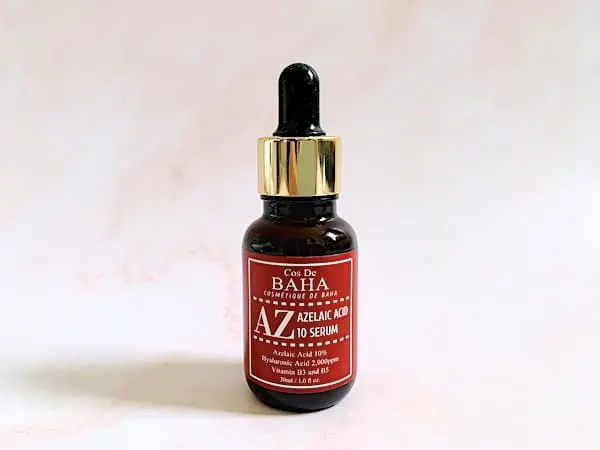
Cos De BAHA Azelaic Acid 10% Serum is formulated with 10% azelaic acid to brighten the skin and reduce hyperpigmentation, acne scars, and rosacea.
The serum also contains niacinamide, so you get the benefits of both azelaic and niacinamide in one serum!
Panthenol (pro-vitamin B5) offers soothing and healing benefits, and sodium hyaluronate, a more stable form of hyaluronic acid, hydrates and draws moisture to the skin. Witch hazel is an astringent that soothes the skin.
You can use this non-irritating lightweight serum on specific areas of concern on your face or all over your face to reduce discoloration, brighten and gently exfoliate dead skin cells.
Please note that this serum contains plant extracts that provide added fragrance.
Paula’s Choice Boost 10% Azelaic Acid Booster
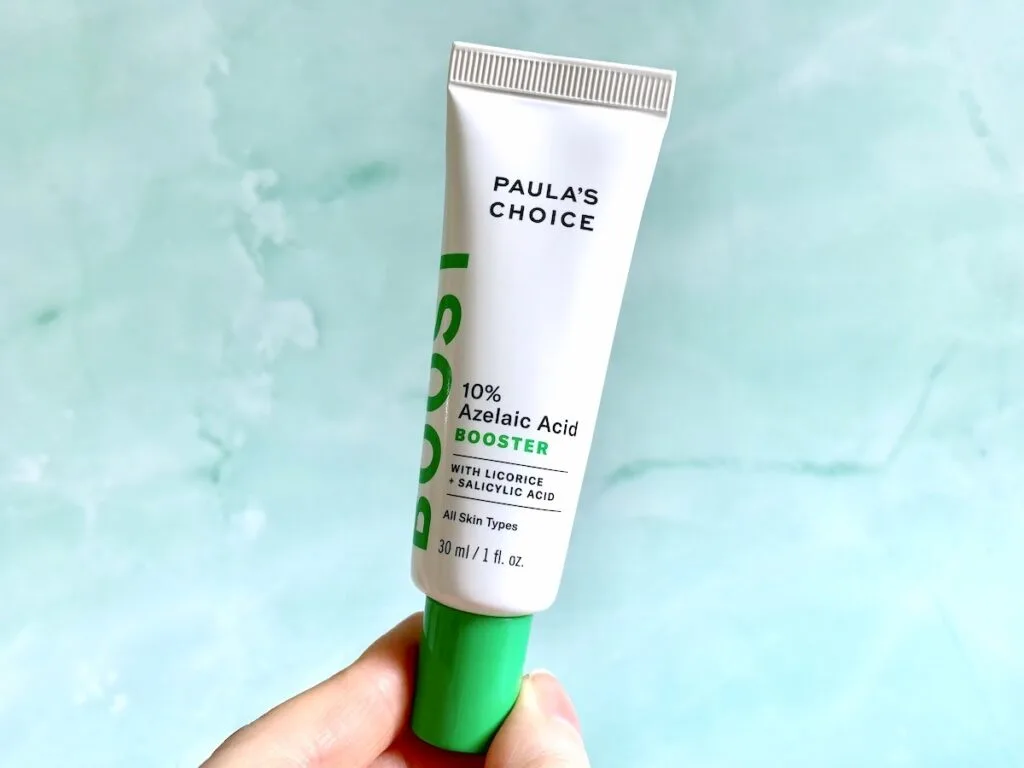
Paula’s Choice Boost 10% Azelaic Acid Booster is a gel cream that targets uneven skin tone, discoloration, bumpy texture, dark spots, and post-breakout marks.
This topical 10% azelaic acid treatment also contains 0.5% salicylic acid to exfoliate inside pores to dissolve sebum (oil), dirt, and impurities to reduce acne and breakouts.
This booster also contains skin-lightening Glycyrrhiza glabra (licorice) root extract, which prevents pigment formation from UVB light and provides anti-inflammatory benefits.
Adenosine helps stimulate collagen production for improved skin firmness, supports a healthy skin barrier, and has anti-inflammatory properties. Allantoin and bisabolol soothe the skin.
This cream-gel treatment is lightweight and oil-free. You can mix it with your favorite serum (i.e., a niacinamide serum) or night cream to boost its effectiveness.
Related Post: Can You Use Salicylic Acid with Niacinamide?
The Ordinary Azelaic Acid Suspension 10%
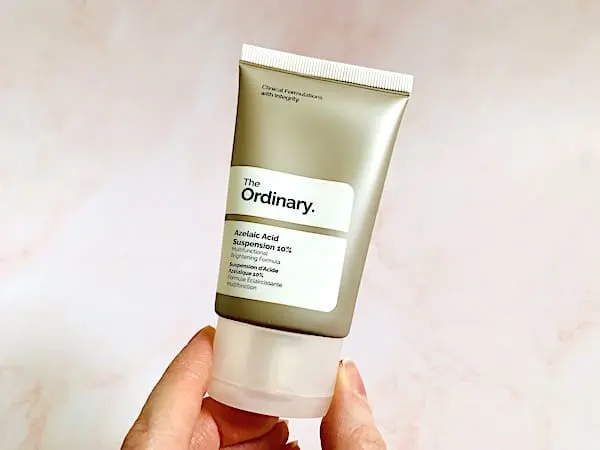
The Ordinary Azelaic Acid Suspension 10% contains a 10% azelaic acid concentration in a lightweight cream-gel. It is formulated to even out skin texture and to reduce the look of blemishes. The formula is enriched with antioxidant vitamin E.
While it’s suitable for all skin types, this suspension ideal for oily and acne-prone skin.
It leaves the skin with a silky feel thanks to the silicone in the formula and can be used as a spot treatment or all over your face for brightening and to reduce breakouts and pigmentation issues.
Is The Ordinary azelaic acid a moisturizer? No, it is not a moisturizer, so you can apply The Ordinary Azelaic Acid after water-based serums and your daily moisturizer.
Paula’s Choice Boost 10% Niacinamide Booster
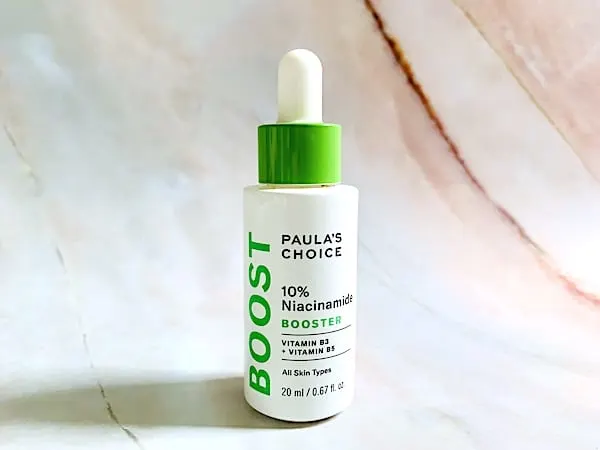
Paula’s Choice Boost 10% Niacinamide Booster is a 10% niacinamide serum booster formulated to improve uneven skin tone and the look of enlarged pores, skin texture, and fine lines.
It also helps to visibly brighten the skin and reduce redness and dryness.
This niacinamide serum is LOADED with skin-loving ingredients:
Niacinamide (vitamin B3) calms and hydrates the skin.
Ascorbyl glucoside, a stable vitamin C derivative, brightens, improves collagen production, and provides antioxidant protection. Sodium hyaluronate (hyaluronic acid) hydrates and acts like a sponge that soaks up moisture.
Glycyrrhiza glabra (licorice) root extract helps brighten the skin. Acetyl glucosamine helps fade hyperpigmentation.
Multiple antioxidants, including ubiquinone, epigallocatechin gallate, carnosine, and genistein, protect the skin. Allantoin and beta-glucan soothe the skin. Glycerin and panthenol moisturize the skin.
The stand-out quality of this serum is its featherlight texture. It feels as light as water on the skin.
It absorbs quickly without any stickiness, making it easy to layer with other products in your skincare regimen.
You can use it on its own or mix it with a serum or moisturizer.
Related Post: Can You Use Niacinamide with Vitamin C?
The Ordinary Niacinamide 10% + Zinc 1%
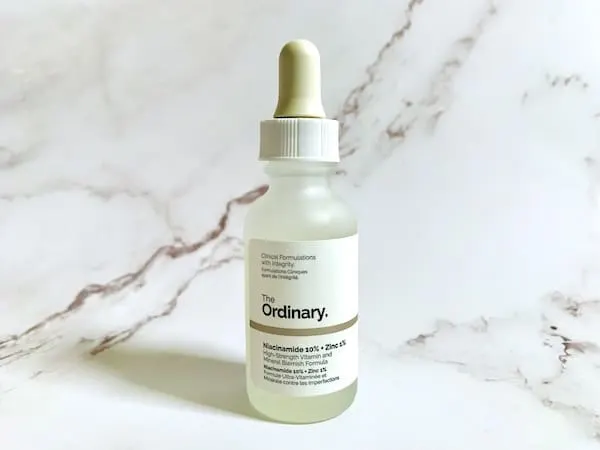
The Ordinary Niacinamide 10% + Zinc 1% is a water-based serum formulated with 10% niacinamide. It also contains 1% zinc PCA (pyrrolidone carboxylic acid) to control sebum activity and support collagen production.
The serum targets congestion, acne scars, balances oil production, and helps to reduce breakouts and the look of pores.
One of The Ordinary’s best-selling products, this niacinamide serum also helps to brighten skin tone and improves textural irregularities. For the low price, it’s a no-brainer!
While The Ordinary notes that this serum is not an acne treatment and recommends benzoyl peroxide and/or retinoic acid for persistent acne-related skin issues and salicylic acid for a temporary improvement in the look of blemishes, this affordable serum is a great choice to use alongside acne treatments for added benefits.
Naturium Niacinamide Serum 12% Plus Zinc 2%
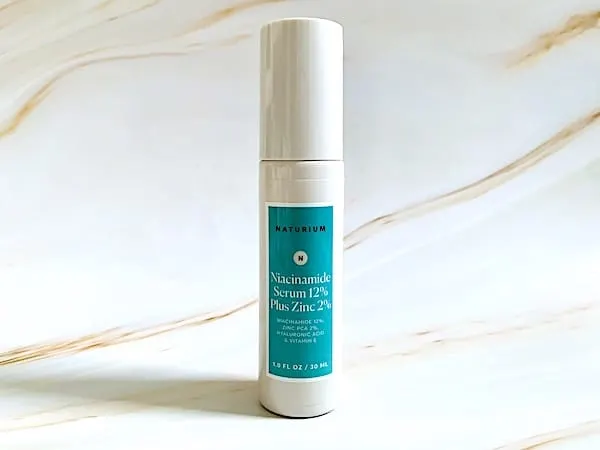
Niacinamide Serum 12% Plus Zinc 2% contains a high concentration of 12% niacinamide plus 2% zinc PCA to minimize the appearance of skin texture, pores, fine lines, and uneven skin tone.
Niacinamide works as a dark spot remover and improves skin texture. Zinc PCA minimizes shine. Hyaluronic acid hydrates and draws moisture to the skin for a plumped appearance.
This affordable serum purifies congested skin and works to balance excess oil production. The serum is formulated for dry, acne-prone, sensitive, and combination skin.
It has an elegant texture that works well with other skincare and makeup products.
Related Post: Can You Use Niacinamide with Retinol?
Final Thoughts on Using Azelaic Acid and Niacinamide Together
While azelaic acid and niacinamide offer multiple benefits for the skin when used alone, when used together, azelaic acid and niacinamide zero in on excess oil, acne, breakouts, redness, hyperpigmentation, and post-acne marks.
With azelaic acid, you also get a gentle chemical exfoliation, and with niacinamide, you receive skin barrier support. Use them alone or together for brighter and healthier skin.
Thanks for reading, and until next time…here’s to your good skin health!
